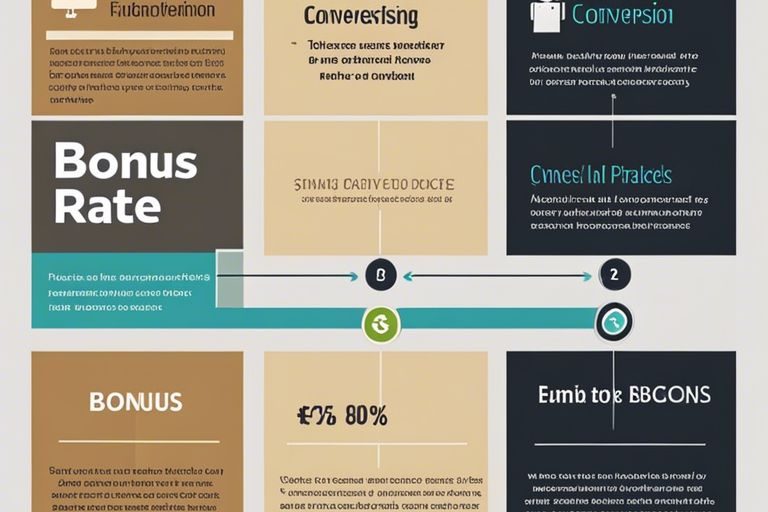Understanding Bonus Conversion Rates

It’s crucial for businesses to grasp the concept of bonus conversion rates in order to effectively measure the success of their incentive programs. Conversion rates play a significant role in determining the impact of bonuses on overall business performance. Understanding how to calculate and optimize these rates can maximize the return on investment for companies.
The Psychology of Bonuses
Before delving into bonus conversion rates, it is crucial to understand the psychology behind bonuses and how they affect employee motivation and performance. Bonuses can have a significant impact on employee behavior and mindset, influencing their motivation and overall performance within the organization.
How Bonuses Affect Employee Motivation
Psychology: Bonuses serve as a form of extrinsic motivation, enticing employees to work harder to achieve specific goals or targets in exchange for a financial reward. The promise of a bonus can drive employees to go above and beyond their regular duties, leading to increased productivity and performance. However, it is crucial to note that while bonuses can boost motivation in the short term, they may not always result in sustained high performance.
The Impact of Bonus Structures on Employee Performance
Impact: The design of bonus structures can have a profound impact on employee performance and behavior. A well-structured bonus system that aligns with organizational objectives and values can incentivize employees to focus on key priorities and contribute effectively to the overall success of the company. Conversely, poorly designed bonus structures can lead to unintended consequences, such as fostering a competitive environment among employees or promoting short-term thinking over long-term goals.
Affect: It is crucial for organizations to carefully evaluate and tailor their bonus structures to ensure they positively affect employee performance and motivation. By aligning bonus incentives with strategic objectives and providing clear and transparent communication about bonus criteria, organizations can maximize the impact of bonuses on employee behavior and drive. Regularly reviewing and adjusting bonus structures based on performance outcomes can help organizations optimize their bonus programs for long-term success.
Types of Bonuses
The bonus landscape in today’s workforce is diverse, with various types of bonuses offered to employees based on different criteria. Understanding the different types of bonuses can help employers design effective bonus programs that drive performance and engagement.
| Performance-Based Bonuses | Sign-On and Retention Bonuses |
| Profit-Sharing Plans | Non-Cash Bonuses and Incentives |
Performance-Based Bonuses
With performance-based bonuses, employees are rewarded based on achieving specific performance targets or goals. These bonuses are often tied to individual, team, or company-wide performance metrics, such as sales targets, project completions, or customer satisfaction ratings. Performance-based bonuses can motivate employees to strive for excellence and contribute to the overall success of the organization.
Sign-On and Retention Bonuses
Sign-on bonuses are offered to attract top talent to an organization, especially for critical roles or in competitive job markets. Retention bonuses, on the other hand, are given to existing employees to encourage them to stay with the company for a certain period. These bonuses can help reduce turnover rates and ensure continuity in key positions within the organization.
Another popular type of bonus is the referral bonus, which is provided to employees who successfully refer qualified candidates to the company. This helps tap into employees’ networks and can result in hiring high-quality candidates.
Profit-Sharing Plans
Performance-based bonuses are often integrated into profit-sharing plans, where employees receive bonuses based on the company’s financial performance. Profit-sharing plans can align the interests of employees with the organization’s goals, creating a sense of ownership and accountability. Plus, these bonuses can be a powerful incentive for employees to work towards the company’s profitability and success.
Non-Cash Bonuses and Incentives
The use of non-cash bonuses and incentives, such as gift cards, travel vouchers, or extra paid time off, can also motivate employees and enhance their job satisfaction. These bonuses offer employees unique perks and experiences that go beyond monetary rewards, contributing to a positive workplace culture. It is necessary for employers to tailor non-cash bonuses to the preferences and needs of their employees to maximize their impact.
Best Practices in Bonus Conversion
Setting Clear and Achievable Goals
All successful bonus conversion programs start with clear and achievable goals. It is vital to define the objectives of the bonus program in a way that aligns with the overall business strategy. These goals should be specific, measurable, attainable, relevant, and time-bound (SMART). When employees have a clear understanding of what is expected of them and know how their performance will be evaluated, they are more likely to be motivated to reach those goals.
Linking Bonuses to KPIs
Any bonus system should be directly linked to key performance indicators (KPIs) to ensure that the rewards are tied to measurable outcomes. By aligning bonuses with KPIs, employees understand what they need to achieve to be eligible for bonuses. This transparency helps in fostering a performance-driven culture within the organization and motivates employees to work towards achieving the desired results.
Linking bonuses to KPIs provides a clear roadmap for employees to follow and gives them a sense of direction in their day-to-day activities. This alignment ensures that bonus payouts are tied to actual performance metrics, making the reward system fair and objective.
Transparency in Bonus Calculation
Best practices in bonus conversion emphasize the importance of transparency in bonus calculation. Employees should have a clear understanding of how their bonuses are being calculated to avoid any confusion or ambiguity. Clear communication regarding the bonus calculation criteria helps in building trust and credibility in the bonus system.
Linking bonus calculation to specific, measurable metrics creates a transparent process that employees can easily track and understand. This transparency not only enhances the credibility of the bonus program but also motivates employees to strive for excellence in their performance to earn the rewards.
Calculating Bonus Conversion Rates
Identifying Core Metrics
Many businesses focus on measuring the effectiveness of their bonus programs through bonus conversion rates. This key metric helps companies understand how well their bonuses are motivating desired actions from their target audience. To calculate bonus conversion rates accurately, businesses must first identify the core metrics that influence the conversion process.
The Formula for Bonus Conversion Rate
Conversion rates are calculated by dividing the total number of desired actions taken by the total number of bonus offers or promotions presented to customers. This formula is crucial in determining the success of bonus campaigns and identifying areas for improvement. By tracking bonus conversion rates over time, businesses can gauge the effectiveness of their bonus programs and make data-driven decisions to optimize their results.
This critical metric gives businesses valuable insights into the performance of their bonus offers and promotions. By understanding the formula for bonus conversion rates, companies can measure and analyze the impact of their bonuses on customer behavior and overall sales performance.
Examples of Conversion Rate Calculations
Conversion rates can vary depending on the type of bonus program and the company’s industry. For example, a company offering a 20% discount bonus on a product may calculate its conversion rate by dividing the number of purchases made with the bonus by the total number of bonus redemptions. Rates A higher conversion rate in this scenario would indicate that the bonus offer is enticing customers to make a purchase.
By analyzing different scenarios and calculating conversion rates for various bonus programs, businesses can gain valuable insights into the effectiveness of their bonuses and make informed decisions to drive better results. Understanding how to calculate and interpret conversion rates is important for companies looking to optimize their bonus programs and maximize their ROI.
Optimizing Bonus Strategies
Now let’s look into how you can optimize your bonus strategies to increase conversion rates. By tailoring bonuses to different employee roles, you can ensure that each team member feels motivated and valued.
Tailoring Bonuses to Different Employee Roles
Any successful bonus strategy must take into account the unique responsibilities and goals of various employee roles within the organization. Sales representatives may respond well to performance-based bonuses, while customer service agents may prefer recognition bonuses for outstanding customer feedback. By customizing bonus structures to align with the specific needs and preferences of each role, you can maximize their effectiveness and drive better results.
Monitoring and Adjusting Bonus Schemes
Roles play a crucial role in ensuring the success of your bonus schemes. It is imperative to regularly monitor the performance and engagement of employees to determine the effectiveness of the bonuses. Analyzing key metrics such as productivity, job satisfaction, and turnover rates can help you identify any areas where adjustments may be needed to optimize the impact of your bonus strategies.
Monitoring and adjusting bonus schemes should be an ongoing process to continuously improve their effectiveness. By staying proactive and responsive to feedback from employees and key performance indicators, you can make timely adjustments to ensure that your bonus strategies remain aligned with the evolving needs of your workforce.
Integrating Feedback into Bonus Strategies
Strategies for integrating feedback into bonus strategies are imperative for ensuring that incentives remain relevant and impactful. Bonuses should be designed in a way that aligns with the preferences and motivations of employees, which can be informed by gathering feedback through surveys, focus groups, or one-on-one discussions.
Bonuses that successfully incorporate feedback from employees are more likely to be well-received and drive desired behaviors. By regularly seeking input and making adjustments based on employee feedback, you can demonstrate your commitment to valuing their contributions and creating a positive work environment.
Optimizing
Optimizing your bonus strategies involves continuously evaluating their performance and making data-driven adjustments to ensure they remain effective. By tailoring bonuses to different employee roles, monitoring and adjusting bonus schemes, and integrating feedback into your strategies, you can create a bonus system that motivates and rewards employees in a way that drives sustained success for your organization.
Challenges and Pitfalls
Common Mistakes in Implementing Bonus Programs
Pitfalls in implementing bonus programs can lead to adverse outcomes in conversion rates. One common mistake is setting unrealistic goals or criteria for employees to achieve in order to receive bonuses. This can create a sense of unfairness and demotivation among the workforce. Another pitfall is not clearly communicating the bonus structure and how it aligns with the overall business objectives, leading to confusion and ambiguity.
Legal Considerations and Compliance Issues
Legal considerations and compliance issues play a crucial role in the implementation of bonus programs. It is necessary to ensure that bonus programs comply with labor laws and regulations to avoid legal disputes or penalties. Organizations must also pay attention to issues such as equal pay and discrimination to maintain fairness and transparency in bonus distribution.
Considerations must be made to ensure that bonus programs do not inadvertently violate any employment laws or create a discriminatory environment. Employers should conduct regular audits of their bonus programs to ensure compliance with legal requirements and address any potential risks proactively.
Managing Employee Expectations
Legal considerations are important when managing employee expectations around bonus programs. Employers must be transparent about the criteria for earning bonuses and the process for determining bonus amounts. Setting clear expectations can help employees understand the value of their efforts and maintain motivation to achieve bonus targets.
Challenges in implementing bonus programs require careful attention to legal considerations, clear communication, and transparency in managing employee expectations. By addressing these pitfalls proactively, organizations can create a bonus program that motivates employees, aligns with business objectives, and complies with legal requirements.
Summing up
As a reminder, understanding bonus conversion rates is crucial for businesses looking to incentivize customers effectively. By knowing how to calculate and analyze these rates, companies are able to make informed decisions when devising bonus programs to drive sales and customer engagement. It’s crucial for businesses to monitor these conversion rates closely and make any necessary adjustments to ensure that the bonuses are adding value and delivering the desired results.
Ultimately, having a clear understanding of bonus conversion rates empowers businesses to optimize their bonus strategies and enhance their overall performance. By focusing on improving conversion rates, companies can bolster customer loyalty, drive revenue growth, and stay competitive in today’s crowded marketplace.
Recommended Posts

MasterCard Payment Solutions for Online Casinos
July 1, 2024

Multi-Currency Platforms in Online Casinos
July 1, 2024

eCOGRA: Ensuring Fair Play at Online Casinos
July 1, 2024




